St. Athanasius the Great
St. Athanasius the Great, Patriarch of Alexandria in the 4th century, known as the “Champion” and “Pillar” of Orthodoxy, is considered to be one of the greatest Fathers of the Orthodox Church as well as one of the most brilliant defenders of the Christian faith and especially of orthodox Christology (i.e. the Biblical teaching about Christ).
He was born in Alexandria of Egypt around 296 to pious Christian parents.
Although very little is known about his early life, Rufinus of Aquileia, in his continuation of the Church History of Eusebius, “records an incident typical of stories about great persons who while children acted out their later roles”.
 Bishop Alexander of Alexandria had invited his clergy to celebrate with him the memory of St. Peter the archbishop of Alexandria and martyr, who was beheaded by the Romans a few years ago, during the Maximinus’ persecution against the Christians. While waiting for his guests to arrive, Alexander looking out of his window he saw at a distance some boys on the seashore playing a game: “They were mimicking a bishop and the things customarily done in church. Now when he had gazed intently for a while at the boys, he saw that they were also performing some of the more secret and sacramental things. He was disturbed...
Bishop Alexander of Alexandria had invited his clergy to celebrate with him the memory of St. Peter the archbishop of Alexandria and martyr, who was beheaded by the Romans a few years ago, during the Maximinus’ persecution against the Christians. While waiting for his guests to arrive, Alexander looking out of his window he saw at a distance some boys on the seashore playing a game: “They were mimicking a bishop and the things customarily done in church. Now when he had gazed intently for a while at the boys, he saw that they were also performing some of the more secret and sacramental things. He was disturbed...
{When the boys were brought to him} they disclosed in due order what they had done, admitting that some catechumens had been baptized by them at the hands of Athanasius, who had played the part of the bishop in their childish game. Then he carefully inquired of those who were said to have been baptized what they had been asked and what they had answered, and the same of him who had put the questions, and when he saw that everything was according to the manner of our religion, he conferred with a council of clerics and then ruled, so it is reported, that those on whom water had been poured after the questions had been asked and answered correctly need not repeat the baptism, but that those things should be completed which are customarily done by priests”. (Rufinus, Ecclesiastical History 10.15).
It was probably after that incident that Athanasius was taken under the care of Alexander, who apparently saw in the young man the potential for spiritual greatness. Christian church historian Sozomenus speaks of his "fitness for the priesthood", and calls attention to the fact that he was "from his tenderest years practically self-taught". He had been well educated, and was versed in grammar and rhetoric, and had already, while still a young man, and before reaching the episcopate, given proof to those who dwelt with him of his wisdom and acumen" (Sozomenus, Ecclesiastical History II, xvii). Whether at the "Didascaleion," the famous catechetical school of Alexandria, and the museum, the ancient seat of the Alexandrian university, or in a private study course, he received a fine classical education, but he acquired more knowledge by diligent study of the Holy Scriptures.
Sometime in his early twenties, Athanasius wrote a two part treatise addressed to a convert from heathenism (paganism), which constitutes the first classic work of developed Orthodox theology. In his first part entitled Against the Gentiles he attacks several pagan practices and beliefs. The second part is his celebrated work On the Incarnation of the Word, which presents teachings on the redemption explaining why Jesus Christ is God and why God became flesh (incarnate) in order to save mankind. This work which “has been read and referenced by Christians through the ages since his day” remains even today the definitive statement of orthodox Trinitarianism!
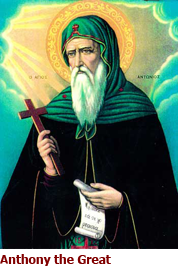 All his life Athanasius was an enthusiastic supporter of monasticism. During his studies or shortly thereafter he established spiritual relations with many ascetics living in the Egyptian desert in the earliest flowering of the monastic life in the East. He was especially acquainted with St. Anthony the Great, whose life he wrote later on. This work of his proved to be a great inspiration to monasticism in both East and West. Later on during his exile to Gaul and his visit to Rome he helped found some of the first monasteries in the West.
All his life Athanasius was an enthusiastic supporter of monasticism. During his studies or shortly thereafter he established spiritual relations with many ascetics living in the Egyptian desert in the earliest flowering of the monastic life in the East. He was especially acquainted with St. Anthony the Great, whose life he wrote later on. This work of his proved to be a great inspiration to monasticism in both East and West. Later on during his exile to Gaul and his visit to Rome he helped found some of the first monasteries in the West.
The martyrdoms, which the Alexandrian Church suffered during the later period of the Roman persecutions against the Christians witnessed by Athanasius as a child and his intimacy with the holy hermit and anchorite Anthony “had all their effect upon his character, and served to nurture in him that undaunted fortitude and high spirit of faith by which he became distinguished”.
As the years rolled by Athanasius was advancing spiritually and eventually became Alexander’s secretary and closest companion and was ordained deacon by him in 319.St.
In the same year a priest of the Alexandrian Church named Arius began teaching that Jesus, the “Son of God”, was not consubstantial or coeternal with God the Father but that there was a time when He (Jesus) did not exist and that He had been created by God – a heretical teaching that came to be known as Arianism, which polarized rapidly and threatened with a schism the entire Christian world. That prompted Emperor Constantine the Great to call for an Ecumenical Council where this Christological issue could be formally resolved.
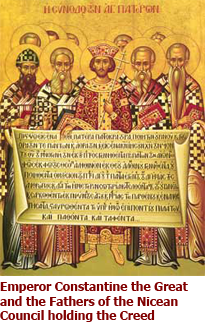 This First Ecumenical Council met in 325 in Nicaea of Bithynia. Many of the 318 Church Fathers attended bore the glorious marks of the sufferings they had endured for Christ during the Roman persecutions; others had spent many years in prison. “There were the hermit-Bishops of Egypt, Paphnutius and Potamon, who had each lost an eye for the Faith; Paul of Neo-Caesarea, whose muscles had been burnt with red-hot irons, and whose paralyzed hands bore witness of the fact; Cecilian of Carthage, intrepid and faithful guardian of his flock; James of Nisibis, who had lived for years in the desert in caves and mountains, Spyridion, the shepherd-Bishop of Cyprus, and the great St. Nicholas of Myra, both famed for their miracles”.1
This First Ecumenical Council met in 325 in Nicaea of Bithynia. Many of the 318 Church Fathers attended bore the glorious marks of the sufferings they had endured for Christ during the Roman persecutions; others had spent many years in prison. “There were the hermit-Bishops of Egypt, Paphnutius and Potamon, who had each lost an eye for the Faith; Paul of Neo-Caesarea, whose muscles had been burnt with red-hot irons, and whose paralyzed hands bore witness of the fact; Cecilian of Carthage, intrepid and faithful guardian of his flock; James of Nisibis, who had lived for years in the desert in caves and mountains, Spyridion, the shepherd-Bishop of Cyprus, and the great St. Nicholas of Myra, both famed for their miracles”.1
At the side of the aged Patriarch of Alexandria, like a faithful watchdog, stands his secretary, the young deacon Athanasius who is to become the chief protagonist in defending and defining the traditional Christian belief handed down from the Apostles about the divinity of Jesus Christ.
Arius is called upon to explain his doctrines. His discourse is long and eloquent. He uses to the utmost his powers of fascination. He tries to hide the full meaning of his words under beautiful expressions, but his meaning is clear to all - "Jesus Christ is not God! 1
In a few words, sharp and clear as diamonds, Athanasius tears to pieces the veils in which the Arians had shrouded their true meaning. "Who has deceived you, O senseless, to call the Creator a creature?" 1
Athanasius vigorously defends the “homoousion” formula that states that Jesus Christ is not of similar essence (or substance) but of the same or one essence with the Father proving that Christ is God just like His Father is. As Theodoret (i. 26) states, in this glorious Council, which produced the Nicene Creed and anathematized Arius and his followers, Athanasius “contended earnestly for the apostolic doctrines, and was applauded by their champions, while he earned the hostility of their opponents”!
A few months later, while the enemies of the truth were in exile and peace had temporarily prevailed, the holy Patriarch Alexander laid on his deathbed calling for his beloved Athanasius, but there was no reply. Athanasius had fled from the city, fearing from certain words he had heard from his bishop that he would be chosen to succeed him. "Athanasius!" called the Patriarch once more, "you think you can escape, but it shall not be so." And with these words he died.
The same thought had been in the hearts of all. Athanasius, known for his zeal and learning, his mortified life, and his ardent love of God was young, it was true, but he was wiser than many older men. When the Bishops of the Church assembled to elect their new Patriarch, the faithful population of Alexandria surrounded the church, holding up their hands to Heaven and crying, "Give us Athanasius!" And the Bishops did exactly that. Athanasius was thus elected unanimously, as St. Gregory tells us, by the vote of the whole people, not in the evil fashion which has since prevailed, nor by means of bloodshed and oppression, but in an apostolic and spiritual manner, he is led up to the throne of Saint Mark. (Gregory Nazianzus: Oration 21, On Athanasius of Alexandria).1
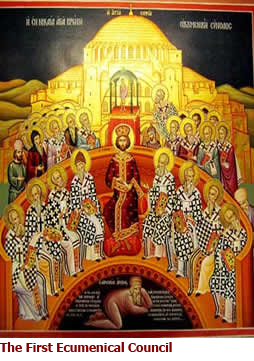 While the first few years of his episcopate were rather tranquil and uneventful, the storm of persecution which was to fall with such fury upon St. Athanasius was already gathering. The Council of Nicaea had settled the creed of Christendom, but had by no means composed the divisions in the Church which the Arian controversy had provoked. Arius himself still lived, and his friend Eusebius of Nicomedia rapidly regained influence over the Emperor Constantine. The result of this was a demand made by the emperor that Arius should be re-admitted to communion. Athanasius stood firm, and refused to have any communion with the advocates of a "heresy that was fighting against Christ." Constantine was baffled for the moment; but many accusers soon rose up against one who was known to be under the frown of imperial displeasure. When Athanasius continued to speak against them as heretics, pro-Arian bishops began to foment controversies against the young bishop. False witnesses called by his hostile opponents in “robber councils” went as far as to accuse the patriarch of Alexandria of lies, cruelty, even with sorcery and murder. False allegations laid against him included threatening to interfere with the empire’s supply of grains from Egypt, taxing the city to provide linen vestments for the clergy, exchanging treasonable correspondence with an enemy of the emperor, having authorized the sacrilege and profanation of the holy vessels and sacred books in a church in the Mareotis, a part of his diocese, as well as having ravished a virgin woman consecrated to God! 2
While the first few years of his episcopate were rather tranquil and uneventful, the storm of persecution which was to fall with such fury upon St. Athanasius was already gathering. The Council of Nicaea had settled the creed of Christendom, but had by no means composed the divisions in the Church which the Arian controversy had provoked. Arius himself still lived, and his friend Eusebius of Nicomedia rapidly regained influence over the Emperor Constantine. The result of this was a demand made by the emperor that Arius should be re-admitted to communion. Athanasius stood firm, and refused to have any communion with the advocates of a "heresy that was fighting against Christ." Constantine was baffled for the moment; but many accusers soon rose up against one who was known to be under the frown of imperial displeasure. When Athanasius continued to speak against them as heretics, pro-Arian bishops began to foment controversies against the young bishop. False witnesses called by his hostile opponents in “robber councils” went as far as to accuse the patriarch of Alexandria of lies, cruelty, even with sorcery and murder. False allegations laid against him included threatening to interfere with the empire’s supply of grains from Egypt, taxing the city to provide linen vestments for the clergy, exchanging treasonable correspondence with an enemy of the emperor, having authorized the sacrilege and profanation of the holy vessels and sacred books in a church in the Mareotis, a part of his diocese, as well as having ravished a virgin woman consecrated to God! 2
Although Athanasius proved his innocence in all of the above accusations, his tribulations caused by the intrigues of his enemies lasted for many years. Four times he was obliged to abandon his city and his beloved flock. Out of his 46 years of episcopate he spent more than 18 years in exile suffering for the faith. But during his forced absences from Alexandria, the Bishop was able to sustain and to spread in the West, first at Trier, the capital of Gaul, and then in Rome, the Nicene faith as well as the ideals of monasticism.
With few exceptions, throughout his turbulent and stormy life he was persecuted by heretics. Of the emperors, he was persecuted mostly by Constantius, Julian and Valens; of the bishops, by Eusebius of Nicomedia and many others; and by the heretic Arius and his followers. Few are the saints who were so mercilessly slandered and so criminally persecuted as St. Athanasius. He was forced to hide from his persecutors, even in a dry well for six years, in private homes, in the deserts as well as in an ancestral tomb for four months! Twice he was forced to flee to Rome. But despite all these he steadfastly maintained and zealously advocated the orthodox faith in the divinity of Jesus Christ and its importance to our salvation. So great were his lifelong struggles for the true Christian faith that the Orthodox Church recognized him as “the most heroic among the saints and the most holy among the heroes”. It is a cold fact of history that Athanasius stood virtually alone against the onslaught of heretical teaching ravaging the Church of his day – begetting the familiar phrase, "Athanasius contra mundum", that is, "Athanasius against the world".
There were times, such as during the reign of Constantius II, when Athanasius and his faithful flock “went through fire and through water” (Psalm 66:12). Especially when the Emperor replaced Athanasius with Arian Bishop George of Laodicea, Arian persecutions against non-Arians got so bad that prompted Athanasius to write his more emotional History of the Arians, in which he described Constantius as a precursor of the Antichrist! Here is a brief description of that dark and ugly period in the history of Christianity that reminds us of the atrocities perpetrated by the Crusaders in 1204 during the conquest of Constantinople or by the Ottomans in 1453 during the fall of the same city.
“Once again into the darkness of the winter's night, while soldiers searched everywhere for the Patriarch, Athanasius fled, an exile and a fugitive. It was indeed the hour of darkness, and it seemed as if the powers of evil were let loose upon the world. The Arians, with the Emperor on their side, were carrying everything before them. Nearly all the Bishops who had upheld the Nicene faith were in exile or in prison. "Fear not for this power is of the earth and cannot last," cried St. Anthony, "as for the sufferings of the Church, was it not so from the beginning, and will it not be so until the end? Did not the Master Himself say, 'They have persecuted Me, they will persecute you also'?" Did not the "perils from false brethren" begin even in the lifetime of those who had been the companions of Christ? And yet, had not the Master Himself promised that, although she must live in the midst of persecution, He would be with His Church for ever, and that the gates of Hell should not prevail against her?
Men and women were seized and scourged; some were slain. Athanasius was denounced as a "run-away, and evil-doer, a cheat and an impostor, deserving of death." Letters came from the Emperor ordering all the churches in the city to be given up to the Arians, and requiring the people to receive without objections the new Patriarch whom he would shortly send them”. 1
St. Anthony, in the year 339, had seen in a dreadful vision, mules surrounding the Holy Altar of the Skete, jumping up and down and kicking the Altar and had heard a voice saying, "My altar will be defiled", and clearly foretold, as St. Athanasius, St. Jerome, and St. Chrysostom assure us, the havoc which the Arian persecution was to make two years later in Alexandria.
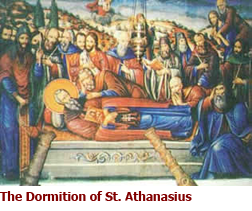 Finally, in the latter half of 364, after decades of persecution, Athanasius was officially and publicly pardoned by Emperor Valens and was allowed to return to his diocese. There he spent the remaining years of his life peacefully as the good shepherd among his good flock who truly loved him. His great soul patiently endured all for the love of Christ and, in the end, emerged victorious from this entire, terrible and long-lasting struggle.
Finally, in the latter half of 364, after decades of persecution, Athanasius was officially and publicly pardoned by Emperor Valens and was allowed to return to his diocese. There he spent the remaining years of his life peacefully as the good shepherd among his good flock who truly loved him. His great soul patiently endured all for the love of Christ and, in the end, emerged victorious from this entire, terrible and long-lasting struggle.
In the spring of 373, "in a good old age," he ceased from all his work. Having consecrated one of his presbyters his successor, he died peacefully in his own house surrounded by his clergy and faithful. His “many struggles," according to his panegyrists, won him "many a crown." He was gathered to his fathers, patriarchs, prophets, apostles, and martyrs, who had contended for the truth.
In addition to his proficient defenses of orthodox Christology and besides his aforementioned masterpieces “On the incarnation of the Word” and “Life of Anthony” Athanasius also left behind many other notable works both of monastic instruction and of defense of the Orthodox Faith.
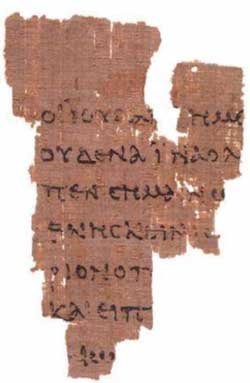 Athanasius was also the first person to formally identify (and canonize) the same 27 books of the New Testament that are in use today. Up until that point, the lists of appropriate works tended to vary throughout the Christian community. This milestone in the evolution of the canon of New Testament books can be found in his Easter (Festal) Letter from Alexandria, written in 367, which is usually referred to as his 39th Paschal Epistle, where he clearly acknowledges that these 27 writings “are the fountains of salvation, that he who thirsts may be satisfied with the living words they contain. In these alone the teaching of piety is proclaimed. Let no one add to these; let nothing be taken away from them.
Athanasius was also the first person to formally identify (and canonize) the same 27 books of the New Testament that are in use today. Up until that point, the lists of appropriate works tended to vary throughout the Christian community. This milestone in the evolution of the canon of New Testament books can be found in his Easter (Festal) Letter from Alexandria, written in 367, which is usually referred to as his 39th Paschal Epistle, where he clearly acknowledges that these 27 writings “are the fountains of salvation, that he who thirsts may be satisfied with the living words they contain. In these alone the teaching of piety is proclaimed. Let no one add to these; let nothing be taken away from them.
The Church formally adopted this New Testament canon by a Synod in Hippone in 393 and the Synod of Carthage in 397.
Papyrus 52, also known as the St John's fragment,is the oldest known manuscript fragment of the New Testament. It is conserved at the John Rylands University Library Manchester, UK. The front (recto) contains lines from the Gospel of John 18:31–33,in Greek, and the back (verso) contains lines from verses 37–38. Although it is generally accepted as the earliest extant record of a canonical New Testament text, the dating of the papyrus is by no means the subject of consensus among critical scholars. The style of the script is strongly Hadrianic, which would suggest a most probable date somewhere between 117 CE and 138 CE. But the difficulty of fixing the date of a fragment based solely on paleographic evidence allows a much wider range, potentially extending from before 100 CE past 150 CE.
The above text includes excerpts from:
1 Standard Bearers of the Faith series, volume Saint Athanasius, by F.A. Forbes, R & T Washbourne, LTD Paternoster Row, London, 1919 Nihil Obstat:J.N. Strassmaier, S.J., Imprimatur: EDM. Can. Surmont
2 Encyclopedia Britannica
Ninth Edition, Vol. II
Charles Scribner's Sons, New York, 1878